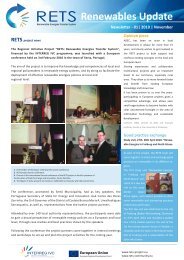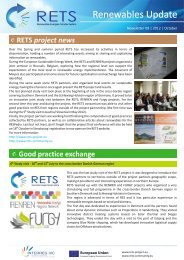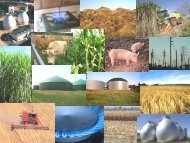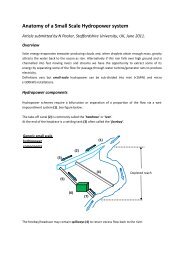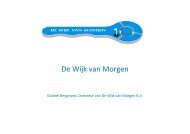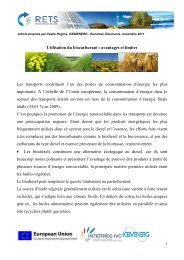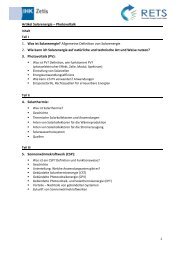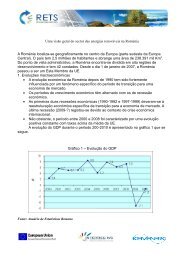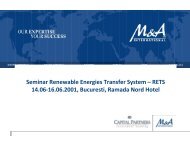Promoting renewable energies - RETS Project
Promoting renewable energies - RETS Project
Promoting renewable energies - RETS Project
You also want an ePaper? Increase the reach of your titles
YUMPU automatically turns print PDFs into web optimized ePapers that Google loves.
Offshore: Offshore wind velocities are higher and more<br />
predictable than onshore. Moreover they do not attract<br />
the same level of visual/acoustic impact complaint as<br />
land based developments. Focusing on locations of up to<br />
30km offshore and water depths of up to 40m, there is a<br />
huge potential wind energy resource for electricity<br />
production in the seas around the EU coastline (>3000<br />
TWh/annum,~5% of global wind resource).<br />
Employment, market development and generating<br />
capacity<br />
The total cumulative installed capacity for wind energy<br />
(2010) across Europe was reported as being<br />
approximately 85,000 MW peak with leaders being<br />
Germany, Spain, Italy, France and Italy. Annual wind<br />
sourced electricity production was approximately<br />
149 TWh across the region with Spain, Germany, the UK,<br />
France and Portugal leading the league of generators.<br />
It is estimated that employment linked with the<br />
manufacture and deployment of this technology across<br />
the EU is in excess of 250,000. The European wind<br />
employment league is topped by Germany followed by<br />
Spain, Italy and Denmark.<br />
The market is valued to be around €29,000 million.<br />
Research, development and demonstration in the EU<br />
Generating electricity from the wind was first<br />
demonstrated in the 19th century. However wind turbines<br />
are still a high-tech product requiring a critical<br />
understanding of meteorology, aerodynamics, stress and<br />
mechanical vibration, electronic control, transient power<br />
production and grid integration. Co-operation between<br />
universities, manufacturers, financial institutions and end<br />
–users is co-ordinated by the European wind energy<br />
association (EWEA) and other bodies.<br />
EWEA state ‘the key areas for current wind<br />
energy research are:<br />
Improving the design and layout of wind farms;<br />
Increasing the reliability, accessibility and<br />
efficiency of wind turbines;<br />
Optimising the maintenance, assembly and<br />
installation of offshore turbines and their<br />
substructures;<br />
Demonstrating large wind turbine prototypes and<br />
large, interconnected offshore wind farms;<br />
New methods of grid management to allow high<br />
levels of wind power in the system;<br />
Expansion of education schemes and better<br />
training facilities.’<br />
The European commission 2009 communication<br />
‘Investing in the development of low carbon technologies’<br />
proposes investing 6 billion euro of private and public<br />
funds in wind power research between 2010 and 2020.<br />
<strong>RETS</strong> Compendium – © 2012 <strong>RETS</strong> Consortium<br />
29




